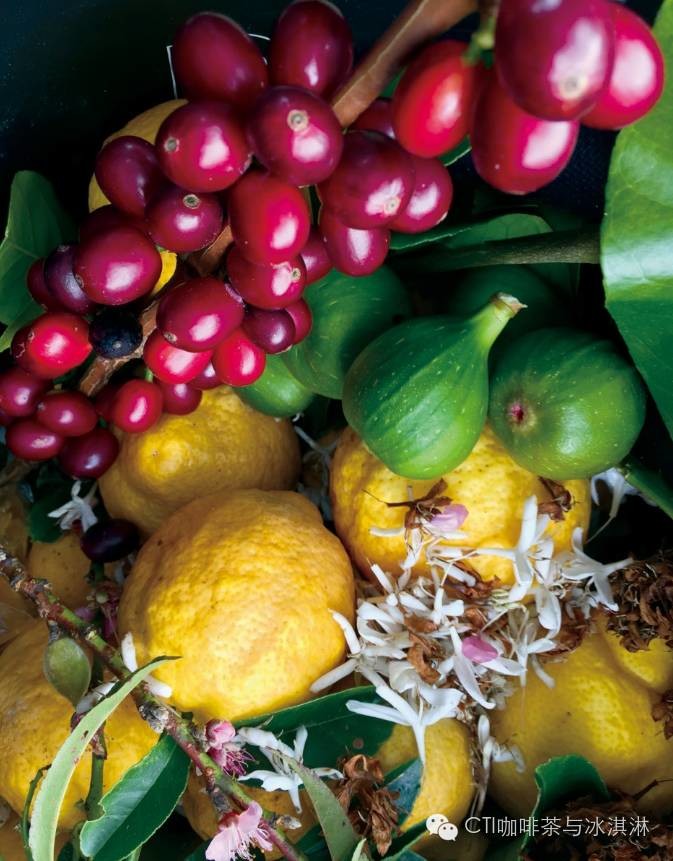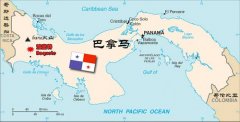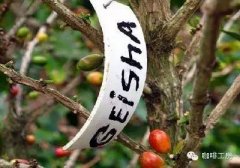Reveal the reason why Panamanian coffee is so popular all over the world

Global coffee production is affected by many factors, and these factors are even more important for coffee flavor: variety, planting altitude, treatment, storage, all of which are indispensable.
However, there is one factor that is closely related to all of the above-climate.
The impact of climate on coffee cultivation is more important than any of the above. I will look at the unique climate of coffee producing areas around the world and explore how these climates affect the growth and flavor of coffee.
Let's start with western Panama.
A trip to Panama
The first time I went to Panama, the whole trip coincided with the rainy season. The so-called "dry" is only when the rain is steady and the sky becomes bright, when driving does not need to turn on headlights, and most of the time is unusually wet: torrential rain slaps plants and roofs, and the roads are muddy.
It was August 2008, and at first I thought it was atypical, and sometimes I even thought I was the "god of rain". But in fact, the whole August is the rainy season in Panama, and the rainy weather here makes it completely different from other coffee-growing countries.
Panama is famous for the unique and gorgeous flavor of its coffee, which is closely related to the local climate. I can't help but wonder how much of the amazing flavor of the Panamanian summer, or how much of such high-priced additions benefit from the climate?
The unique geographical environment of ●
Central America is a long isthmus from northern Mexico to southern Colombia, connecting North and South America. Panama is located in the southernmost part of Central America, so the country runs from east to west, not from north to south as people think. This means that the coast of the Caribbean (Atlantic) is in its north, while the Pacific is in the south.
Panama is by far the narrowest country that shares the Atlantic and Pacific coastlines. And this has a far-reaching impact on coffee production. In the coffee-producing area of Chiriqu í, the hometown of world-famous estates such as Hacienda La Esmeralda, Elida Estate, Finca Nuguo, and Finca La Mula, it is only 60-70 kilometers from the sea.
The oceanic climate is a huge system that covers the entire hemisphere. Other currents in the Caribbean originate as far away as Iceland, while some east-west currents in the Pacific Ocean originate half a world away off the coasts of Japan and Indonesia. On the island of Panama, which is less than 100 kilometers wide, these global climate systems intertwined and collided, creating amazing microclimate change. The wind swirled and changed direction; it rained without warning, and the clouds floated on the hills with fog and ice rain.
And the boutique coffee farms in Panama, in the middle of these chaotic climates.
The interaction between ● climate and environment creates a charming flavor.
Willem Boot, owner of two Panamanian farms Finca Sao í an and Finca La Mula, also grows Rosa Coffee, which is also an award-winning variety. In February 2015, I went to Finca La Mula Manor with the professional manager of Boot, along with my friend Kelly Hartmann, a Panamanian native. In summer in Panama, the climate from January to April is much drier than when I first visited Panama. But Boot reminds me that when you get to the farm, you will find that "dry" is only relative. "this is basically a forest in the clouds, and when the clouds come, the temperature will drop sharply." This is how Boot describes it. We climbed the steep hillside of the manor and passed through the thick clouds, which covered everything.
La Mula is a dense forest, with huge shade trees covering most of the planting area. There is also a second layer of shade trees that grow lower than them, and under this vault are rosy summer coffee trees that have a unique flavor because of the environment.
Boot told us: "if the cloud period is regular and becomes a regular phenomenon, it shows that it can cause some unique situations for trees." Especially in the presence of fruit trees, plants will respond to the environment and adjust themselves. When there is no sunlight, the leaves get a higher water supply, and the photosynthesis of the trees is slow, which lengthens the ripening period of cherries, making the flavor stronger, especially in terms of sweetness and acidity. " So will humidity make it more difficult to grow? "it doesn't matter," Boot said. "We want these unique things to happen, and that's what makes them unique."
The thick forest ensures that the clouds can last on the hillside. Under the combined action of trees and clouds, combined with high altitude, coffee can grow in a cool and humid environment.
● 's unique geographical location creates a unique flavor.
Finca Nuguo Manor is getting better and better on the world coffee stage, with the exception of some coffee that won senior competitions, where beans were used in the 2016 US barista champion Lemuel Butler competition. Finca Nuguo Manor is located in Chiriqu í in western Panama, close to the Costa Rican border.
"it's raining hard here, and even in the dry season, Rain Water continues to be here." Jos é Gallardo, the owner of Finca Nuguo, said, "I think these trees will love the rain, which means the nutrition will be good all year round." Water brings all the nutrients of the year to the root layer of the tree. "
In addition to the official rainy season, Finca Nuguo Manor also experienced an unusual rainfall (as did La Mula), which Panamanians call "bajareque". The rain was coming so fast from the Atlantic that I even saw clouds like waves covering a corner of the hillside. Standing on the top of the mountain, the second before it was covered by strong sunlight, you could see the clouds sliding slowly between the two slopes, like a blanket. Before you realize what happened, the next second you are already in the bajareque. The cold Rain Water is very small, just like a silver needle, the temperature plummets and almost tingles your skin. Bajareque has caused a lot of trouble for local farmers, but Finca Nuguo Manor's Jos é Gallardo told us: "in a tropical rainforest, trees love the rainy season. The trees in the dry areas are very similar, the leaves are scarce and the ground is dry. But in Nuguo, if you go into the jungle, you will find leaves everywhere. Everything is soft. "
Boot commented on this phenomenon: "this is a combination of several factors: unique forest climate, a lot of rainfall, cloud-shrouded forests." Because of this unique climate, we get a lot of planting materials, which create a very complex organic matter in the soil. Constant moisture helps these materials degrade, while hyperactive microbial bacteria create a special metabolism to help trees get nutrients. Higher elevations and cold weather conditions mean more complex oils in coffee. We can't measure this accurately, but we can taste it, and I've consulted botanists that the unique color of coffee, such as the unique reddish hue observed at Finca Nuguo Manor, is also related to these complex oils. "
● is not just happy.
Under such exciting conditions, it will bring a lot of challenges
As you can see, all coffee cultivation depends on the unique growth environment of western Panama. The weather is the most important part of the whole story. Fortunately, these special environments create a special flavor, which makes all the hard work valuable.
1. Exposure to the sun
At Finca Nuguo Manor, washed coffee usually takes weeks to dry, while sun-cured coffee takes months. In order to reduce the water content of the coffee to 14%, Gallardo needs to drive the coffee beans to his friends in low-altitude cities and use a dehydrator to complete the final steps. These additional steps increase the richness and complexity of coffee flavor, but time-consuming and labor costs directly lead to a sharp increase in the price of the final product.
two。 Wind
Panamanian winds can also be extremely intense. "it's a bad thing for Nuguo no matter where the wind comes from. Sometimes we have to watch the trees die, but we don't plant in places where there is often a strong wind. " Gallardo is managed by keeping tropical rain forests in their most pristine state, so when pruning and managing trees, they usually consider in advance how to guard against the wind. As a result, their main coffee growing and producing areas are concentrated in areas protected by natural windbreaks. "I hope I can plant more trees in the future. Protecting the forest is very important to us. " Gallardo said.
3. Manpower
Roads and driving conditions are another problem. The mountain road is often blocked because of frequent rain. Kelly Hartmann, the manor manager, was trapped on the mountain because of a sudden mudslide. "it will take them hours to escape from the mountains," Boot said. Gallardo told us that they will provide workers with plastic raincoats, and dealing with the weather is always a consideration, in addition to roads, workers, everything.
At Finca Sofia Manor, the temperature is sometimes very low, so the structure of the house is very important. Boots told us: "A good residential environment can withstand wind, rain and cold, so you can sleep better." This has a great impact on your state the next day.
▲
About the author:
Daniel Millard Humphries
Work for Origin Coffee Network
Production manager, has visited many coffee producing areas and has contributed to a number of foreign magazines.
Important Notice :
前街咖啡 FrontStreet Coffee has moved to new addredd:
FrontStreet Coffee Address: 315,Donghua East Road,GuangZhou
Tel:020 38364473
- Prev

The new favorite of boutique coffee-Panamanian Coffee Poket Butterfly
Panama is a Central American country bordered by Costa Rica to the west and Colombia to the east. Anyone who knows anything about individual coffee should know that Panamanian coffee is famous in the coffee world as the geisha Geisha (the name of Rosa) in the Emerald Manor. It can be said that it is a country that strives for excellence in coffee and is rich in high-quality coffee. Panamanian coffee is famous for the rosy summer of the Emerald Manor, while
- Next

Introduction to Panamanian producing areas and manors
The finest coffee in Panama (Panama) is grown in the west of the country, near Costa Rica and the Pacific Ocean. The Boquet district of Chiriqui province is the most famous for its coffee, as well as Wakan, Santa Clara and Kendra. Other areas include David, Remacimeinto, Bugaba and Toto.
Related
- Detailed explanation of Jadeite planting Land in Panamanian Jadeite Manor introduction to the grading system of Jadeite competitive bidding, Red bid, Green bid and Rose Summer
- Story of Coffee planting in Brenka region of Costa Rica Stonehenge Manor anaerobic heavy honey treatment of flavor mouth
- What's on the barrel of Blue Mountain Coffee beans?
- Can American coffee also pull flowers? How to use hot American style to pull out a good-looking pattern?
- Can you make a cold extract with coffee beans? What is the right proportion for cold-extracted coffee formula?
- Indonesian PWN Gold Mandrine Coffee Origin Features Flavor How to Chong? Mandolin coffee is American.
- A brief introduction to the flavor characteristics of Brazilian yellow bourbon coffee beans
- What is the effect of different water quality on the flavor of cold-extracted coffee? What kind of water is best for brewing coffee?
- Why do you think of Rose Summer whenever you mention Panamanian coffee?
- Introduction to the characteristics of authentic blue mountain coffee bean producing areas? What is the CIB Coffee Authority in Jamaica?

